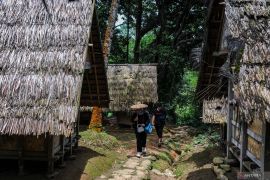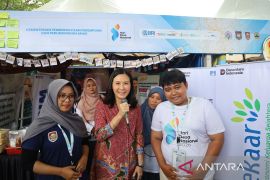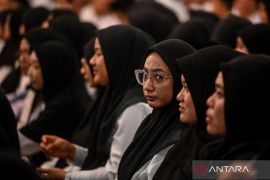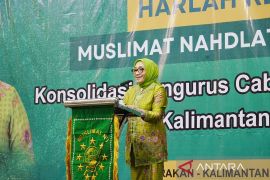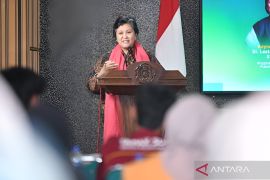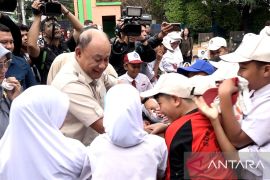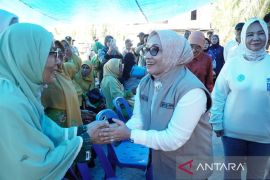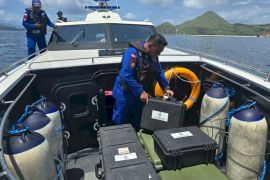We will continue to encourage Badui farmers to develop huma paddy and contribute to food security of their familiesJakarta (ANTARA) - Baduy Luar (Outer Baduy) women from traditional settlements in Kanekes Village, Leuwidamar, Lebak, scuttle to the fields at dawn to uphold the tradition of growing huma paddy (paddy grown in fields) and palawija (secondary crops).
The huma paddy cultivation movement was conducted in early October according to the traditional calendar schedule, and the harvesting will be conducted in the next six months or in April 2022.
The Baduy women would walk up to tens of kilometers to the location of the fields.
During the journey, they typically wear a hood or large hat made of woven bamboo to protect themselves from the sun. They also carry along rice and food while staying in the field.
They farm to help their husbands, who had earlier cleared fields in the hilly areas.
The hilly land, which was originally a forest, was cleared by the Baduy farmers by cutting down trees and chopping weeds.
Following the mandate of their traditional ancestors, Baduy farmers always change locations every year while planting crops.
Most Baduy agricultural fields are located in the hills owned by outside Badui residents as well as in Perum Perhutani, a state forest enterprise, by renting the land.
They later pay the rent by dividing the harvest.
Intercropping is conducted in the farming fields with other crops, such as huma paddy, bananas, ginger, kencur (aromatic ginger), palawija (secondary crops), and also perennials.
By conducting intercropping, they can ensure food availability and economic income for the next three to 12 months and even up to five years.
"We and our husbands feel happy while entering the planting season," Munah, 45, a Baduy woman, who rented a field from Perum Perhutani in Cicuraheum Block, Lebak District, stated.
Related news: Minister upbeat about Baduy making Baten world tourism destination
Rainy season
The Baduy women were fortunate, as the planting movement was conducted during the rainy season, thereby making it easier to plant grains in the soil.
They carefully insert the grain into a hole, or "ngaseuk,” at a specified distance, so that the huma paddy flourish.
Farming during the rainy season is usually guaranteed to produce abundant harvest without plant diseases.
They could also easily make holes to plant bananas, secondary, and other crops.
Related news: Lebak to develop 29 tourist destinations
Loyalty
Generally, Baduy women grow crops to help their husbands in the field as a form of loyalty, Munah stated.
Munah has been farming since she got married up until now.
This is because the Badui community’s economic income and food availability are derived from their farming harvest.
Baduy women are obliged to help their husbands in the fields for a happy and prosperous family.
So far, no Baduy women are unemployed once they are married, and some even live with their husbands in the fields for months.
“We farm for the welfare of our family as well as to show loyalty in the household,” Munah noted.
Related news: baduy tribe preserves conservation forest - (d)
Field
Baduy people are now entering the planting season after clearing forest lands in the hills to serve as farming fields.
“The forest clearing went smoothly, and no poisonous snakes were found," a Baduy farmer named Pulung, 55, stated.
Huma paddy and secondary crops are then planted on the land.
They grow the huma paddy on the hill and mountain lands since the soil is fertile.
Baduy farmers still conduct farming without resorting to the use of chemical fertilizers.
They make organic fertilizer by burning the remnants of clearing shrubs, trees to weeds and waste.
"Our wives help us in carrying out the planting movement," he stated.
Baduy people rely on their fields to meet their family's food requirements as well as to boost their economy.
Related news: Indonesian govt to promote Baduy land as culture tourism center
Moving from place to place
Indigenous elder and head of Kanekes Village, Leuwidamar Sub District, Lebak District, Jaro Saija stated that all Baduy farmers are currently starting to cultivate crops in hill areas to be used as fields for huma paddy and secondary crops.
Baduy farmers are required to change the location of their farming fields every year to maintain ancestral customs.
Apart from farming huma paddy, Baduy farmers also plant secondary crops and vegetables.
Usually, secondary crops and vegetables are sources of economic income, as the harvests are sold to the market.
"We hope that the harvest will be abundant, and there will be no pests or plant diseases," Saija noted.
So far, food insecurity or hunger has not been found in the Baduy community with a population of 4,320 head families and 14,600 people spread over 68 villages.
Head of the Lebak District Agriculture and Plantation Service, Rahmat Yuniar explained that Baduy farmers make a big contribution to food availability.
They have two thousand food houses, with an average of four tons, and can store up to 800 thousand tons of grain.
"We will continue to encourage Badui farmers to develop huma paddy and contribute to food security of their families," Yuniar affirmed.
Related news: COVID-19: Indigenous Baduy people enthusiastically get vaccinated
No crisis
Tono Soemarsono from Public Relations of the Baduy Community Consultation (Wammby) explained that Baduy people residing in the Kendeng Mountains inland, Lebak District, have also never experienced a crisis or threat of hunger owing to their simple and efficient lifestyle.
The life of the Baduy community is simple, and the money they earn from handicrafts and harvests is managed well.
Baduy people prefer to use their money for investment and savings, such as buying land and gold.
Settlements in the Baduy area are also prohibited from having permanent houses as well as electronics and vehicles.
The ban is based on the customs of their ancestors, which the Baduy people must obey, Soemarsono explained.
In fact, several Baduy communities own large areas of land outside the customary land rights area to be used as income for farming.
So far, the farming field developed by the Baduy community contributes food and substantial economic income from huma paddy, durian, koranji (tamarind), bananas, petai (bitter bean) and jengkol (djengkol bean) commodities, and secondary crops.
During the durian and koranji (tamarind) harvest season, Baduy people can even earn profits reaching up to hundreds of millions of rupiah.
However, the Baduy community do not sell their huma paddy, as it is used to ensure the family's food security.
The output of the huma paddy harvest, or the grains, are stored in food houses, or "leuit," behind the house.
Related news: Economic recovery in Indonesia continues as optimism remains high
Related news: Widodo urges local governments to speed up vaccinations
Editor: Fardah Assegaf
Copyright © ANTARA 2021


